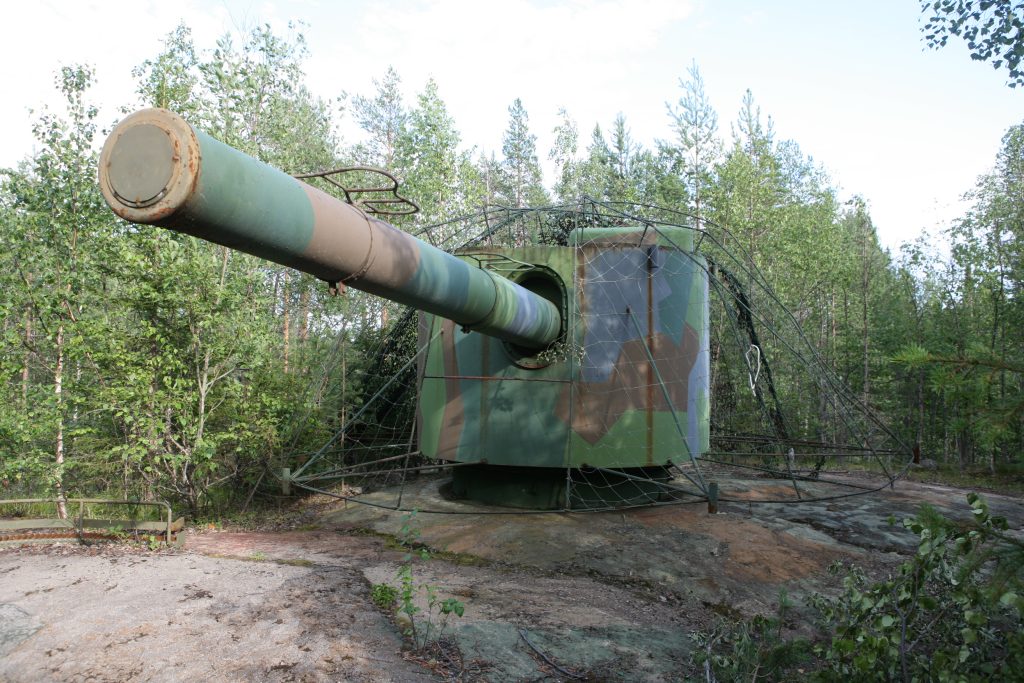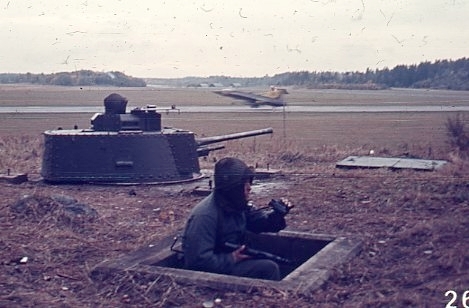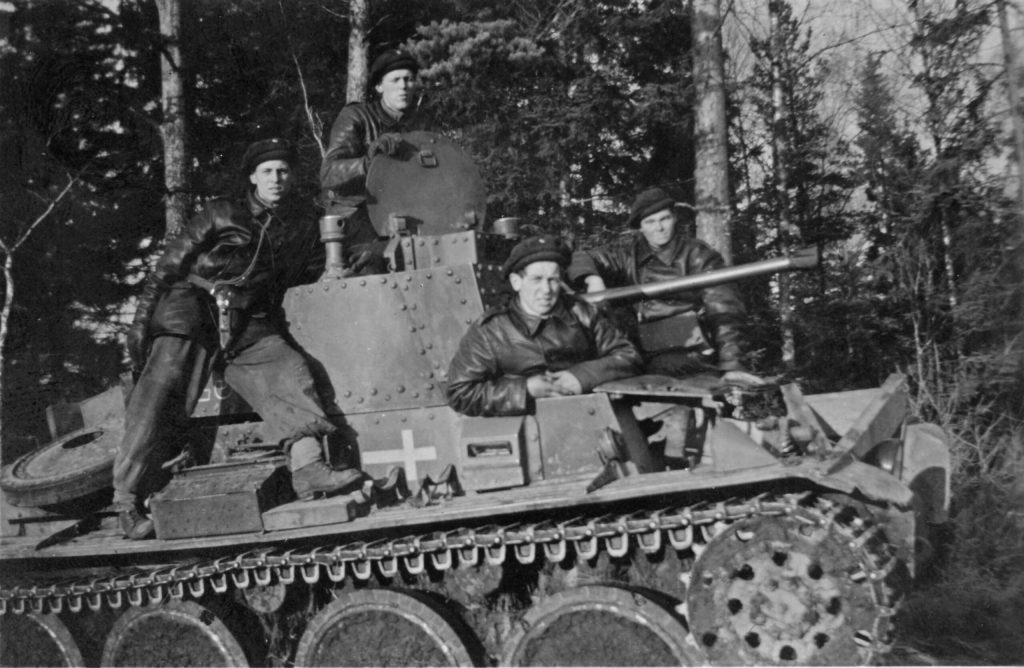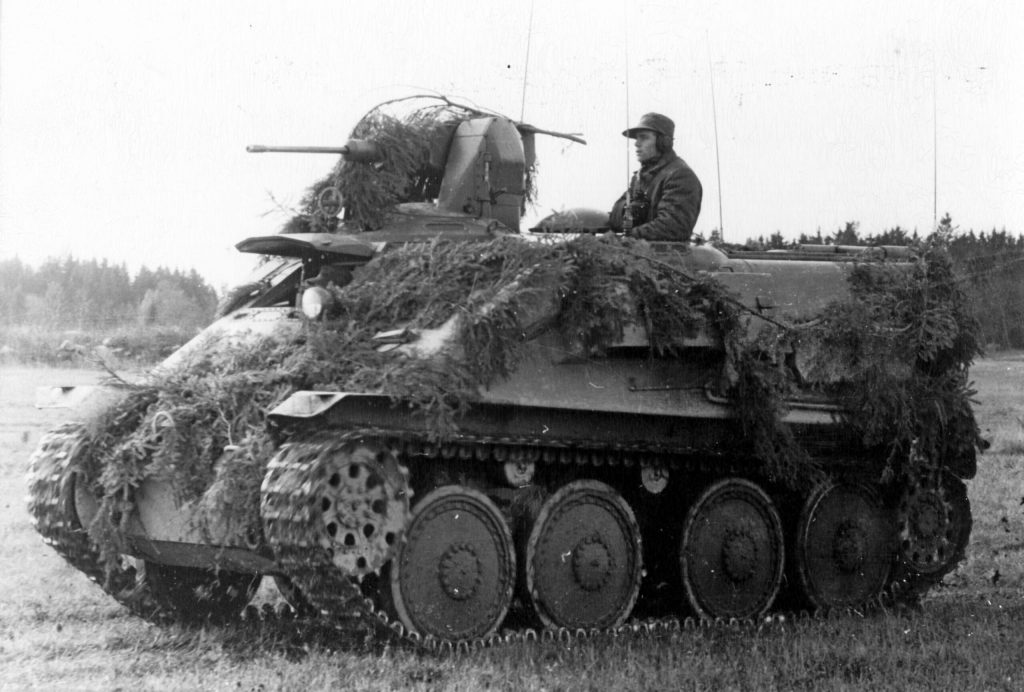Bunker turrets– A history of military recycling
During the Cold War strange green glassfibre domes started to appear all round Sweden, near airfields, harbours, bridges and other strategic places. As a child in the 1980s I saw many large military exercises in the northernmost county of Sweden, Norrbotten, where I lived, and military matters were things that one shouldn’t talk about too much. Even those people with a rather sceptical attitude to the usefulness of the Swedish defence forces in any case thought that one shouldn’t inquire too much. If you saw something that seemed wrong at a military store, it was best to contact somebody in the area who was a Home Guard soldier so that they could find out what was going on.
It was a tantalizing thought that there could be guns under the green domes, but at the same time they demanded respect, because as a child we thought that things like that would be protected by alarms or even booby traps. One of my uncles was an officer in the reserve and occasionally mentioned “värnkanoner” which in a direct translation mean “defensive guns”, but never gave a detailed description of what they were, so I imagined that it was a question of cannons in concrete bunkers like the ones you could see in photographs of the World War 2 Atlantic Wall in Normandy, France.
Exactly what these guns really were became clear to me for the first time in my late teens, and I became very surprised, because in all the pictures I saw there were various kinds of armoured turret with both guns and parallel-mounted machine guns. It was not long before I realised that these turrets were surprisingly similar to those mounted on various old-fashioned tanks. I had learned that Sweden re-used artillery from older warships in a number of fortifications around the country, some of which were very secret. Recycling tank turrets in the same way was after all not so unusual.
Now let’s start to become acquainted with these bunker turrets, in particular the type of turret here in the Aeroseum, namely the m/41 medium tank turret. Partly because it is here, but also because its origin and history are rather complex and serve to emphasise how the defence establishment learned to utilise its resources and find new functionality for material that was still usable despite its age, within its original area of utilisation.

6 inch cannon, originally mounted on the warship Gustav V, used in the Kalix line defences.
Creative military recycling
In the Cold War period, from the 1950s to the 1980s, Sweden implemented a large number of projects whereby defensive works and bunkers were being built, which from an international viewpoint was a large scale project. Nya Berget, which holds the Aeroseum, is one of these projects. They included everything from underground cavern hangars and artillery fortresses to simple firing trenches or pillboxes guarding bridges or fords. In order to provide armaments for these various defensive positions, many guns were made, particularly for coastal forts. In addition to these, certain guns and even complete turrets from older Swedish Navy vessels were given a new life. The largest of these were 11 inch guns taken from the three Sweden class coastal defence ships.
In several locations, such as bridges and airfields, simple fortifications were built with smaller guns, also mounted in turrets. They were called “värnkanoner” and will be referred to as bunker turrets from here on and exemplified creative military recycling. In this case they were turrets from older tanks that were no longer fit for armoured combat, but could still provide fire power in a stationary role. This solution saved time and money. The older conscripts could also make use of their earlier experience to operate these guns. An advantage of a turret, compared with the more usual guns located in bunkers was that they could fire in all directions.
The first turrets to be employed in this way were those taken from light tanks, for example the tanks of types m/41 and m/40. These vehicles were armed with 37 mm cannons, which already at the start of the Second World War had proved to be too weak to be able to fight against newer tank models. By the end of the War in 1945 they were useless against all other tanks. Sweden therefore lagged behind in respect of tanks, but was forced to use what it had. Also, during the War tank armament in general had flourished at a rapid pace, not least in respect of hand-held anti-tank weapons. Now an ordinary infantry platoon could carry a weapon that would be able to stop a light tank in its tracks. Even Sweden’s best tank, the model m/42, was unable to match any foreseeable opponent, although it could perhaps be upgraded or given a new role as a support vehicle for infantry, called in Swedish Infanterikanonvagnar (IKV) whereby its gun could after all shoot powerful explosive shells.
Sweden has a large surface area and a long coastline, with a relatively small population. Being able to defend itself everywhere against a possible aggressor would be difficult, but by means of widespread conscription the Swedish Army could at a maximum call up about 600,000 soldiers, half to fight in the more mobile field element and the other half consisting of older soldiers in local defence units. The latter were spread all over Sweden and the aim was to have them living within their own area and being near to their own local mobilisation stores. This would facilitate faster mobilisation in the case of an enemy attack and buy time to allow the field units to themselves mobilise. In order to increase the defensive capability extensive construction began of every possible form of fortified and protective installations. The previously mentioned Nya Berget was a part of this enormous project. In addition, at the same time more basic defences were being set up at strategic places, sometimes supplemented by bunker turrets. Although bunkers and redoubts would not be able to defeat an attacker, they would however provide defensive units with greater powers of resistance and give Sweden more time to implement full scale mobilisation.
An assailant would most probably try to disrupt and if possible prevent mobilisation. One way of doing this would be to carry out a surprise attack with a small force and try to capture key positions, also if possible to disable the Swedish government. Preferably so quickly that even local defensive units would not have time to react. Stopping mobilisation completely would be difficult, because the Swedish defence administration had spread the mobilisation centres all across the country, although if key points were captured, the Swedish capability to put up organised resistance would be weakened.
The Swedish air force and parts of the fleet would play an important part in the initial stages of responding to an attack. The air force would be on a high state of readiness, and together with active units in the fleet could inflict so serious losses on an attacker that an attempted surprise attack should fail. However airfields and the fixed air force bases would of course be important targets for such an attack.

A manned bunker turret at a Swedish air base: Photograph Digital museum
In the event of a surprise attack, or as it is called in official swedish terminology “strategiskt överfall” (Strategic surprise attack), it would be the currently present under training conscripts along with whatever regular troops who happened to be in the area who could form the defensive personnel. However in addition would be the home guard personnel, which amounted at its height to a force of over 100,000 across the whole country. This consisted of volunteers; for the most part older men aged over 48, along with some elements from volunteer defence groups, and younger personnel who for various reasons, such as chronic illness, were deemed unfit to serve as conscripts. The strength of this arrangement was that the home guard existed over the whole country and would be able to defend its local areas. They were familiar with the terrain and knew each other, and others who lived nearby. This meant that they could more easily notice strangers who could be spies, or in the case of a war starting, saboteurs.
Because the home guard soldiers had their equipment, including weapons and ammunition, at home, they could within a few hours be ready for action. This also meant that it would be the home guard that had the task of protecting mobilisation on the ground. Important places needing protection, such as mobilisation storage, harbours and airfields could be manned. Each unit would have a number of specific objects for which they would be responsible. If the enemy managed to capture an area, it would be home guard that would form the basis for armed resistance in the form of guerrilla warfare.
If an alarm sounded it would be the home guard mission to man the prepared defensive positions, including the bunker turrets, and stay there until relieved by local defensive units. In light of this it was a definite advantage to have the defensive armament consisting of older materiel since this means that the home guard soldiers would very likely be familiar with equipment dating from their own period of conscription. Their greater age would be less important if these soldiers were fighting from prepared positions. All home guard soldiers were, and are, also volunteers and already from the start well motivated to defend their home areas at any cost.
It was in this situation, whereby Sweden’s defence depended on the air force, navy and a tripwire of voluntary home guard troops supported by various ad hoc rapid response units, that the bunker turrets showed they were in the right place. Those enemies that could be expected at this early stage were to some extent spies and saboteurs, along with special units, and in a further stage units landing from ships or the air, who would be the ground-based opposition. These would be units which would probably be well trained and motivated, with good equipment but not equipped with heavy weapons. Above all, not even the Soviet airborne forces, that in time would get vehicles with armour protection and artillery that could be carried by air, would be equipped with tanks. As a defence against lighter vehicles and their occupants the 37 mm cannons, and later 75 mm turret-mounted cannons from the tank type m/42, would be effective. Enemy aircraft and helicopters trying to land on airfields are also very vulnerable to cannons, which due to their armour were protected against most types of weapon that special units and paratroops could carry with them on an initial attack.
Obstacles to tank procurement
At the outbreak of war in 1939 Sweden had only a very small number of tanks. Of these, only 15 were equipped with cannon powerful enough to destroy other tanks, namely the tank type m/38. An order was placed for a first batch of an improved variant with more armour, called the m/39, and 29 of these were in service by 1940.
In respect of tanks, Sweden’s complement in 1939 and 1940 were comparable to those that most other countries had. Their main weapon was a good 37 mm cannon from Bofors, and 37 mm was a common calibre in tanks at that time. Tanks that had been manufactured by the Landsverk Company in Sweden were good, and could hold their own against most other tanks available elsewhere. But Sweden needed more tanks, and just as it had in the case of aircraft, ordered more from abroad. The choice fell on the Czech type TNH Sv CKD that was comparable to the tank type m/39, even though that model was more modern in some respects, especially in respect of the hull construction. Sweden had been the first country in the world to have a production line of tanks with welded hulls, whereas the TNH had a riveted hull.
In 1939 90 tanks of this type were ordered. However Nazi Germany had occupied Czechoslovakia by this time and seized the Swedish-ordered tanks. Swedish protests were ignored. Germany called the TNH tanks “Panzerkampfwagen (PzKpfW) 38 (t)” where the “t” stood for “Tjeck” (Czech in English). The vehicles that had been ordered by Sweden were somewhat different from others, and therefore received the designation “PzKpfW 38 (t) S, where the “S” stood for “Schweden”. These tanks took part in Operation Barbarossa in 1941, Germany’s invasion of the Soviet Union.
Sweden finally managed to negotiate the rights to licence-build tanks, and these received the designation Stridsvagn (Strv) (Tank in English) m/41, and were built by Scania Vabis in Södertälje, not far from Stockholm. Altogether 238 of these tanks were built, although it took until 1943 before they could be put into use, and by then they were obsolescent.
Already by 1941 the German tanks had run into trouble with newer Soviet tanks such as the T-34 and above all the Kv-1. 37 mm guns were no longer powerful enough, but by means of greater mobility and better tactics, the PzKpfW 38 (t) could hold out. By 1943 the Germans were however mainly using these tanks for reconnaissance. Larger turrets could not be fitted, which would be necessary in order to install a larger calibre gun. Nevertheless, these tanks were still very useful and reliable, so their chassis became used as a basis for various armoured vehicles, self-propelled artillery and other support variants.

A Swedish tank crew poses with their strv m/41 tank: Photograph Arne Pettersson/Arsenalen
Armour developments progressed at terrifying speed, and Sweden fell alarmingly behind. The tank type m/42, with its 75 mm gun, entered service towards the end of the war and was to some extent comparable with the Allied standard M4 Sherman tank, although largely obsolete when it was introduced. After the war, Sweden had fallen far behind in respect of tank design, which can be compared unfavourably with the Swedish aircraft industry, which immediately after the war engaged in the design of a modern jet aircraft, the Saab J29 “Flying Barrel”.
Sweden rebuilt some tanks to become support vehicles, such as the assault gun m/43 with a more powerful gun, no turret and less armour. There was no getting away from the fact, however, that Sweden possessed a large force of tanks that were hopelessly outdated.
The decision was made to procure the British Centurion tank, and these were ordered in 1953, with the first deliveries that year. This was a first class tank and was supplemented by a number of Strv m/42 tanks converted into light tanks with new turrets and uprated guns.
As the older Swedish tanks were taken out of service, so their turrets were given a new life as fixed defensive guns. Sweden thus gained several hundred bunker turrets that could be used in fortifications all around the country. This was the birth of the “värnkanonerna” and provided in this way continued use for at least parts of the old tanks.
Total recycling!
The type m/41 tank would however become a special case, because just as the Germans had discovered during the war, this was a very reliable design that operated well and had a lot to give. But what to do with a chassis that still worked well and the basis of an otherwise outdated tank? To be sure some of them had been converted into assault guns, but even these were beginning to be replaced by more capable replacements.
There was however one area where an increased need had been identified. The Swedish armoured brigades had newer and more effective tanks, but these needed support by infantry that needed to ride in vehicles that could keep up with the tanks during an attack. To be sure, Sweden already had armoured vehicles for personnel transport in the form of the KP vehicles, that is to say the Karosseripansarbil m/42 (armoured personnel carrier in English). Unfortunately these did not have the same terrain ability as the Centurion tanks, so these was really a need for tracked vehicles, with sufficient armour to at least protect against small calibre fire and artillery shell splinters.
The tank manufacturer Hägglunds & Sons at Örnsköldsvik began to design a special vehicle that became the pansarbandvagn (armoured tracked vehicle) (Pbv 302) that became a legend in the Swedish Army. But it would take time before this vehicle could enter service and the need was dire. This was where the strv m/41 came on to the scene. It was rather too small, but there were over 200 well-proven vehicles on hand. Hägglunds were given the task of using the chassis and main frame of the strv m/41 to build what would today be called an infantry fighting vehicle to fill the gap before the Pbv 302 would be ready. Work started immediately to design a new cupola. The engines were replaced by a new type, the same as were installed in the Saab Safir aircraft. The vehicles would need armament, and Russian wheeled vehicles with the same function were equipped with a heavy machine gun, as were also the new tracked US vehicles, the M112. West Germany had just brought the SPz 12-3i into service, that was armed with a 20 mm automatic cannon and provided that vehicle with greater firepower than its opponents. But it could only carry five men, which was really the practicable minimum. Its armament was on the other hand in line with what Sweden felt desirable. Plus, there were plenty of 20 mm cannons left over when Sweden withdrew the Saab J 21 fighter aircraft. These weapons were modified and re-designated 20 mm automatic cannon type m/45B.
The vehicle was called the Pbv 301 tracked personnel carrier, and could transport seven battle-equipped soldiers. These were delivered to the Army in 1962 -1963. Altogether 220 were built, almost all of the remaining strv m/41. This was enough to provide every armoured brigade with an infantry battalion of Pbv 301s, while the others had to continue with m/42 medium tanks or even trucks. This however gave Sweden an operable armoured gun that in firepower was superior to everything except the German SPz 12-3 and provided experience until the Pbv 302 could be introduced. Not bad for a design that for the most part consisted of recycled older material! The Pbv 301 was taken out of service after a mere nine years in 1971, but had fulfilled a vital function. When it comes to a successful and creative alternative re-use of military materiel, the m/41 tank, Pbv 301 tracked personnel carrier and m/41 bunker turrets deserves medals.

A Pbv 301 partly camouflaged by pine branches. Photograph: Arsenalen
